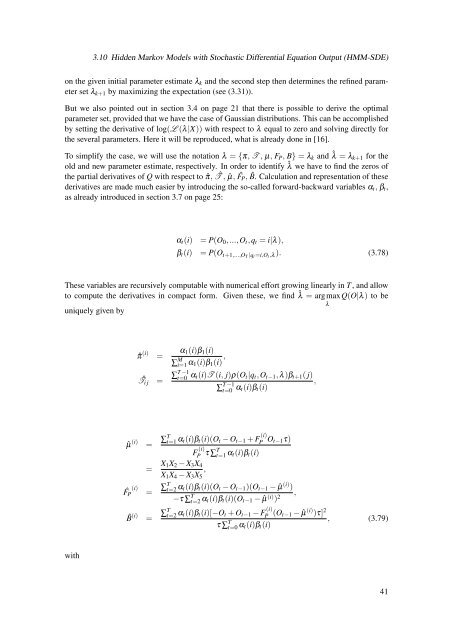Diffusion Processes with Hidden States from ... - FU Berlin, FB MI
Diffusion Processes with Hidden States from ... - FU Berlin, FB MI
Diffusion Processes with Hidden States from ... - FU Berlin, FB MI
You also want an ePaper? Increase the reach of your titles
YUMPU automatically turns print PDFs into web optimized ePapers that Google loves.
3.10 <strong>Hidden</strong> Markov Models <strong>with</strong> Stochastic Differential Equation Output (HMM-SDE)on the given initial parameter estimate λ k and the second step then determines the refined parameterset λ k+1 by maximizing the expectation (see (3.31)).But we also pointed out in section 3.4 on page 21 that there is possible to derive the optimalparameter set, provided that we have the case of Gaussian distributions. This can be accomplishedby setting the derivative of log(L (λ|X)) <strong>with</strong> respect to λ equal to zero and solving directly forthe several parameters. Here it will be reproduced, what is already done in [16].To simplify the case, we will use the notation λ = {π, T , µ, F P , B} = λ k and ˆλ = λ k+1 for theold and new parameter estimate, respectively. In order to identify ˆλ we have to find the zeros ofthe partial derivatives of Q <strong>with</strong> respect to ˆπ, T ˆ , ˆµ, FˆP , ˆB. Calculation and representation of thesederivatives are made much easier by introducing the so-called forward-backward variables α t , β t ,as already introduced in section 3.7 on page 25:α t (i)= P(O 0 ,...,O t ,q t = i|λ),β t (i) = P(O t+1,...,OT |q t =i,O t ,λ ). (3.78)These variables are recursively computable <strong>with</strong> numerical effort growing linearly in T , and allowto compute the derivatives in compact form. Given these, we find ˆλ = argmaxQ(O|λ) to beuniquely given byλˆπ (i) =ˆ T i j =α 1 (i)β 1 (i)∑ M i=1 α 1(i)β 1 (i) ,∑T−1t=0 α t(i)T (i, j)ρ(O t |q t ,O t−1 ,λ)β t+1 ( j)∑ T −1t=0 α t(i)β t (i),ˆµ (i) = ∑T t=1 α t(i)β t (i)(O t − O t−1 + F (i)P O t−1τ)F (i)P τ ∑T t=1 α t(i)β t (i)(i)FˆP= X 1X 2 − X 3 X 4X 1 X 4 − X 3 X 5,= ∑T t=2 α t(i)β t (i)(O t − O t−1 )(O t−1 − ˆµ (i) )−τ ∑ T t=2 α t(i)β t (i)(O t−1 − ˆµ (i) ) 2 ,ˆB (i) = ∑T t=2 α t(i)β t (i)[−O t + O t−1 − F (i)P (O t−1 − ˆµ (i) )τ] 2τ ∑t=0 T α , (3.79)t(i)β t (i)<strong>with</strong>41









